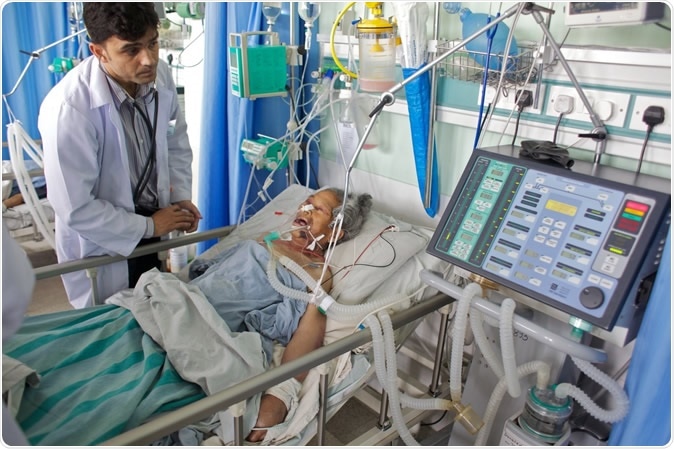According to a new study published in the latest issue of The Lancet, this week, more people across the globe are dying of sepsis than earlier believed. A team from the University of Pittsburgh and University of Washington schools of medicine led the research along with their colleagues from different disciplines.

Image Credit: WHO
The study was presented at the Critical Care Reviews annual meeting in Belfast today and researchers have noted from the statistics that sepsis is killing more children in poorer regions than earlier known. The team found that there have been a total of 48.9 million cases of sepsis around the world in 2017 and of these 11 million have succumbed to the infection. This means that one in five deaths or 20 percent of the deaths across the world are due to sepsis, write the researchers.
Sepsis is an overwhelming form of generalized infection that affects all the major organs of the body. In this condition the infection triggers a massive immune response and the effects of the overactive immunity can damage the major organs that may prove life threatening. Many survivors of sepsis may go on to have co-morbidities and other lifelong ailments and disabilities.
Kristina E. Rudd, M.D., M.P.H., assistant professor in Pitt's Department of Critical Care Medicine, who led this new study said, “I've worked in rural Uganda, and sepsis is what we saw every single day. Watching a baby die of a disease that could have been prevented with basic public health measures really sticks with you. I want to contribute to solving this tragedy, so I participate in research on sepsis. However, how can we know if we're making progress if we don't even know the size of the problem? If you look at any top 10 list of deaths globally, sepsis is not listed because it hasn't been counted.” She is also a critical care physician at the UPMC.
For this study the team looked at data on sepsis from the Global Burden of Disease Study which looked at the global prevalence of the condition and the analysis was performed with a collaboration of researchers from Institute for Health Metrics and Evaluation (IHME) at the University of Washington School of Medicine. The Global Burden of Disease Study 2017 looked at 282 causes of deaths across the globe but does not look at sepsis per se. Sepsis is excluded from the list because it is an intermediate cause of death say the researchers. This means that sepsis is caused by an underlying cause such as a cancer or a severe pneumonia etc. explain the researchers.
This new study took into account the GBD 2017 data because there have been gaps in knowledge regarding the actual prevalence of sepsis including those that occur within and outside the hospitals in the poorer nations. The team explained that till date the data from hospitals were reported only from the high income developed nations. This meant that the actual disease burden could be the whole of the ice berg whose tip was reported say experts.
For this study the team looked at sepsis incidence, prevalence and sepsis associated mortality from the year 1990 to 2017. They found that in 1990 there were 60.2 million cases of sepsis which resulted in 15.7 million deaths across the world. In 2017 the numbers had declined to 48.9 million cases and 11 million deaths – a drop by 19 percent and 30 percent respectively. Lower respiratory tract infections were one of the commonest causes of sepsis the team found.
The team also noted that 85 percent of the cases of sepsis in 2017 were reported from low or middle income nations with largest number of cases reported from poor regions such as sub-Saharan Africa, the South Pacific islands near Australia, and South, East and Southeast Asia. Women were more at risk to die of sepsis than men and there was a high incidence of sepsis during early childhood and 4 in 10 cases of sepsis occurred in children below the age of 5 years.
Study author Mohsen Naghavi, M.D., Ph.D., M.P.H., professor of health metrics sciences at IHME at the University of Washington School of Medicine, in a statement said, “We are alarmed to find sepsis deaths are much higher than previously estimated, especially as the condition is both preventable and treatable. We need renewed focus on sepsis prevention among newborns and on tackling antimicrobial resistance, an important driver of the condition.”
According to lead author Rudd, “So what is the solution? Well, to start with it's basic public health infrastructure. Vaccines, making sure everyone has access to a toilet and clean drinking water, adequate nutrition for children and maternal health care would address a lot of these cases. But sepsis is still a problem here in the U.S., where it is the No. 1 killer of hospital patients. Everyone can reduce their odds of developing it by getting the flu shot, and the pneumonia vaccine when appropriate. Beyond that, we need to do a better job preventing hospital-acquired infections and chronic diseases, like diabetes, that make people more susceptible to infections.” She added, “Finally, for people in high-income countries who want to help reduce the rates of sepsis in low-income areas, we need to support research into treatments and advocate to our elected officials for the importance of supporting sepsis prevention and control efforts in low-income communities.”
The study was funded by the Bill & Melinda Gates Foundation, the National Institutes of Health, the British Columbia Children's Hospital Foundation, the Wellcome Trust and the Fleming Fund.
Source:
Sepsis kills 1 in 5 Globally, Double Previous Estimate - https://www.upmc.com/media/news/011620-rudd-global-sepsis
Journal reference:
Global, regional, and national sepsis incidence and mortality, 1990–2017: analysis for the Global Burden of Disease Study Rudd, Kristina E et al. The Lancet, Volume 395, Issue 10219, 200 - 211, https://www.thelancet.com/journals/lancet/article/PIIS0140-6736(19)32989-7/fulltext